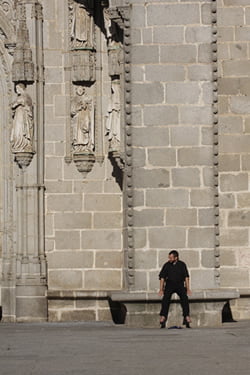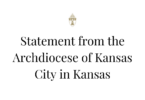
Archdiocesan seminarian Nathan Haverland, outside the Cathedral of San Salvador in Avila, joined other seminarians in walking the town of Avila barefoot in honor of St. Teresa.
by Nathan Haverland and Nancy Ruoff
If the ruby slippers didn’t get the message across, the bright blue T-shirts the pilgrims wore probably did: “Ya no estamos en Kansas”
No, to paraphrase a line from the Sunflower State’s most famous fictional character: They weren’t in Kansas anymore.
Carrying little more than a carry-on bag, a group of 67 pilgrims (teens, young adults, seminarians, chaperones, and priests) left the archdiocese on Aug. 11 for a journey of faith — and a week of activities at the 11th World Youth Day, held from Aug. 15 to 21.
The Kansas pilgrims joined more than 500,000 Catholics from 100-plus countries at the event, who were themselves joined by more than 1.5 million Spaniards for the papal vigil and Mass Aug. 20 to 21.
No party, no disco, no foolin’ around
Pilgrims — or, in Spanish, peregrinos — are people who journey a long distance to a sacred place as an act of religious devotion.
And this was definitely a pilgrimage, not a vacation, said Rick Cheek, co-consultant for the archdiocesan office of evangelization and Catholic youth formation, and it would challenge the pilgrims — not only spiritually, but mentally and physically, as well.
And challenged they were — by the heat, the miles of walking, the blisters, the wind, the rain, the huge crowds, the lack of sleep and the never-ending changes in plans. There were encounters with grace, however, both expected (sacraments) and unexpected.
Spain was not Kansas — from the different kind of heat to the much later meal times: lunch at 2 p.m. and dinner at 10 p.m. Although accommodations at a youth hostel where they first stayed seemed rustic and cramped, it was plush in comparison to what they would experience later.
Toto does Toledo
The pilgrims landed in a country rich in saints three days prior to the start of World Youth Day events. They met up with Archbishop Joseph F. Naumann almost immediately, and made a beeline from there to the stomping grounds of the event’s two patron saints — St. John of the Cross and St. Teresa of Avila — in Segovia, Toledo and Avila.
Their first stop was Segovia, known for its well-preserved Roman aqueduct, majestic castle and towering cathedral. There, the pilgrims attended Mass in a chapel at an ancient Dominican convent and prayed the Liturgy of the Hours at the tomb of St. John of the Cross, a spiritual master known for his great insights into suffering.
Next, they visited Toledo, the former capital of Spain, which boasts a historic castle, cathedral and collection of El Greco paintings. Saint John of the Cross wrote some of his greatest spiritual works while imprisoned in that city in 1577.
Finally, they stopped in Avila, the home of the great Carmelite reformer and spiritual master, St. Teresa of Avila. They prayed at the very place where, on the solemnity of the Assumption many years before, the doctor of the church experienced her spiritual visions.
Having been fortified by these spiritual experiences, the Kansas pilgrims took a step down in the world and settled into — or rather, onto, their new accommodations: the hard, wooden floor of an non-air-conditioned gym. Joining them were 40 English-speaking pilgrims from Australia, England and other countries.
They didn’t complain, however. They, at least, had warm, indoor showers. A group from New York shared six portable outdoor showers with 800 other pilgrims.
The friendly invasion
The friendly invasion had taken over every inch of Madrid. The streets were thronged with joyful pilgrims, belting out hymns, cheers and chants in a babble of languages. The Kansas pilgrims took to the streets with their state and American flags held high — and a dainty pair of ruby slippers on a pole leading the way.
The crowds were larger than anyone ever anticipated. In fact, the streets were so packed that the archdiocesan group couldn’t even make its way to the opening Mass on Aug. 16. It soon became clear that there was no hope of seeing the opening Mass, even from a distance, or the papal welcome and the Stations of the Cross at the Plaza de Cibeles.
With no assigned areas for groups, tens of thousands of pilgrims were jostling and vying for a spot. The Kansas contingent finally found a spot where they could catch at least a glimpse of the events on a huge screen. But then, for unknown reasons, a large dump truck moved through the crowd and parked in front of them, blocking even that view.
At that point, group leaders Rick Cheek and Father Mitchel Zimmerman, archdiocesan vocations director, made a command decision. The group would abandon the futile effort to attend the opening Mass and head instead to the opening session at the Love and Life Center, an English-speaking catechesis site sponsored by the Knights of Columbus and hosted by the Sisters of Life from New York City. There, the pilgrims attended Mass for their group that evening.
As they were leaving the papal opening Mass, however, two Spanish-speaking pilgrims commented on the ruby slippers that heralded the progress of the archdiocesan pilgrims.
“Los zapatos, por qué?” (“Why the shoes?”) asked one.
The other was impatient with his compatriot’s ignorance.
“Dorothy!” he exclaimed, as if it was obvious.
‘Pilgrim up,’ Kansans
The days following the opening Mass began with morning catechetical sessions led by bishops from around the world. One of the highlights of the sessions was a presentation by Archbishop Timothy Dolan of New York, who mixed humor, history and the Gospel with the World Youth Day theme of being “planted and built up in Christ, firm in the faith.”
But both blessings and challenges continued to shower the pilgrims as the week continued. Cheek challenged them to “offer it up,” and indeed they offered up and “pilgrimed” up in the face of difficulties and disappointments. Four fellow pilgrims, for example, formed a team of Sherpas for 16-year-old Josh Ruoff, each time the wheelchair-bound youth from Mother Teresa of Calcutta Parish in Topeka encountered one of the many staircases.
But Friday evening found the group enjoying a World Youth Day tradition — a profoundly moving experience of the Stations of the Cross. The pilgrims sat in silence and prayer as they watched the World Youth Day cross travel from station to station — actually, elaborately decorated floats called “pasos” — as meditations were read and grand orchestral pieces were played.
The ‘grim’ in pilgrim
On Saturday, the pilgrims travelled to Cuatro Vientos Airfield for the final events of World Youth Day, an evening vigil with the Holy Father under the stars and a closing Mass on Sunday.
One of the hottest days of Madrid’s entire summer, the World Youth Day pilgrims loaded the Metro system beyond capacity. Upon arriving, the Kansas pilgrims were greeted with a breathtaking view of the vast crowd filling Cuatro Vientos. Some pilgrims commented that it looked like a massive refugee camp.
This eventually became a cause of frustration, however. Volunteers and security told the Kansans that the “reserved” section to which they had been assigned was already full and they’d have to move more than a quarter of a mile away to find a new place — bare ground covered by straw and bordered by gravel access roads.
Many had prayed for relief from the unrelenting sun — and they got their prayers answered in spades. Shortly after the pope arrived and began the vigil, a sudden storm with rain, lightning and strong winds pummeled Cuatro Vientos and brought the liturgy to a sudden stop. Pope Benedict and hundreds of bishops and dignitaries remained on the stage while at least a million pilgrims tried to shelter themselves and prevent their gear from being blown away.
After no worse than some damage to adoration tents, the storm departed and the vigil recommenced. Several of the seminarians noted that when the Eucharist was finally exposed for adoration, the rain let up and held off until Benediction was complete.
According to one pilgrim, one of the most inspirational moments of World Youth Day was when a sea of exhausted and wet pilgrims knelt in silent prayer with the Holy Father in adoration of the Blessed Sacrament.
“Experiencing the silence with one million people from around the world, kneeling in prayer in adoration before Christ the king, spoke louder to me than any words ever could,” said Kate Ruoff, of Mother Teresa Parish.
Perhaps the most disappointing moment to be “offered up” was an announcement Sunday morning prior to the papal Mass.
Due to the storms and a crowd number well above the organizers’ estimates, the Eucharist had been removed from the adoration chapels overnight for safety and security reasons. Also, Communion from the papal Mass would be available only to a small number of people, including concelebrants and a few sections of pilgrims closest to the altar.
The announcement, made in multiple languages, encouraged pilgrims to stay for the papal Mass and offer up this disappointment as a “sacrifice for the Holy Father,” and then to find another Mass that evening in Madrid to receive Communion.
“Perhaps our inability to receive the Eucharist at [the papal] Mass today will help us realize how precious the Eucharist is, and how often we can take [the Eucharist] for granted,” said Archbishop Naumann during a reflection following an afternoon Communion service.
Of apparitions and exhaustion
Although the Kansas pilgrims were already exhausted, there was one last place to visit: Fatima, Portugal.
Although the Marian apparition site was not originally a part of the pilgrimage, a change in plans was made when it was discovered the group would be flying out of Lisbon, which is not far from Fatima.
Tucked away in a corner of rocky real estate, Fatima has been built up into a quiet place for peaceful prayer. It was here in 1917 that the Blessed Mother appeared to three shepherd children. Today, as then, the Virgin Mary touches the lives of people at Fatima.
The bus journey from Madrid to Fatima took much longer than expected — 10 hours — leaving the pilgrims only two-and-a-half hours to visit, pray, souvenir shop and attend Mass. There, they saw the jeweled Marian crown containing a bullet removed from Blessed Pope John Paul II after the assassination attempt on his life in 1981. He credited Our Lady of Fatima for saving his life that day.
Providentially, it just so happened the day of the visit was the memorial of the Queenship of Mary.
Many of the Kansas pilgrims decided, despite their fatigue, to do the traditional walk on their knees around the Chapel of Apparitions.
“Walking the distance on my knees was not an easy task, but it was so humbling to be on the ground [where the apparition took place],” said 17-year-old Mary Khadivi, of Holy Trinity Parish in Lenexa. “I thought of how Jesus was looked down upon all his life, and the crosses that Christians have to bear.”
No place like home
Due to the lateness of their arrival in Lisbon and poor directions for the bus drivers, the group was forced to abandon their dreams of showers and a few hours of rest in real beds before the flight home. Instead, the Kansas pilgrims camped out in the Lisbon airport for an expected 1 a.m. departure.
Those who couldn’t sleep participated in an impromptu session of “Airport Olympics” at 2:30 a.m., organized by seminarian Mark Ostrowski and chaperone Susan Beam. The events included baggage relays, wheelchair obstacle course, and sleeping bag shuffleboard.
Even mechanical delays and gate changes couldn’t dampen the enthusiasm of the pilgrims, however, as they returned home with their mission: spread the Gospel.






